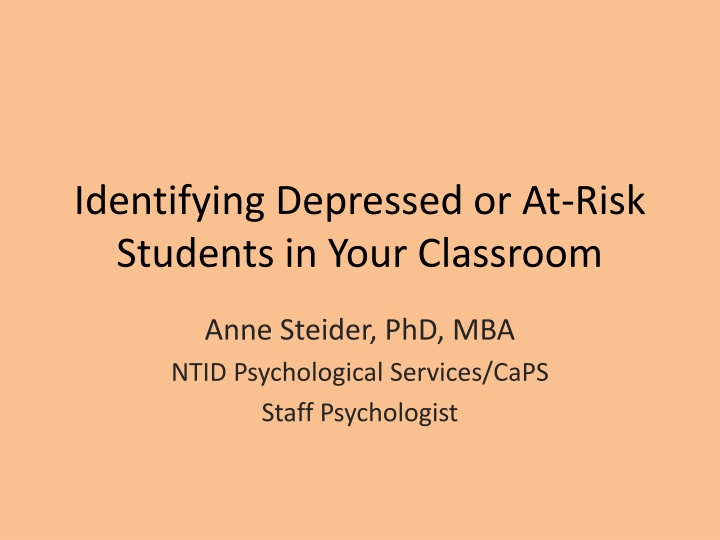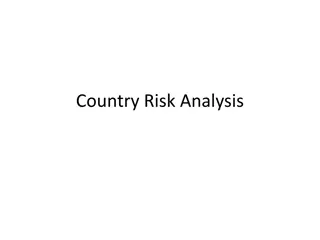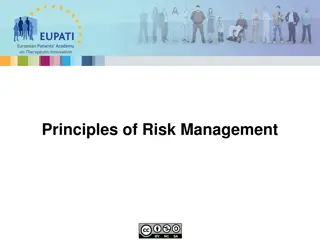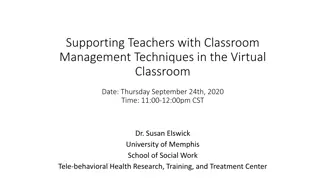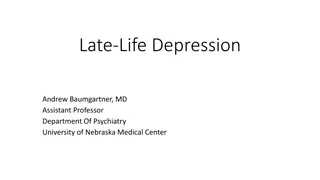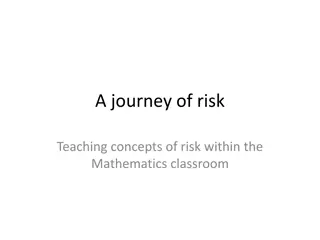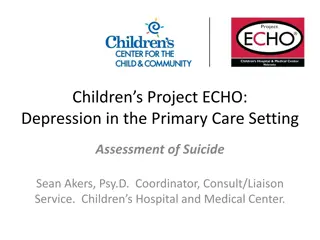Identifying Depressed or At-Risk Students in Your Classroom
This presentation by Anne Steider, PhD, MBA from NTID Psychological Services highlights strategies for identifying and supporting students who may be struggling with depression or at-risk behaviors in a classroom setting. It discusses the importance of distinguishing between disruptive and distressed behaviors, common concerns presented by students, and signs indicating changes in academic performance or behavior. The presentation emphasizes the need for educators to be vigilant and proactive in addressing the mental health and well-being of students.
Download Presentation

Please find below an Image/Link to download the presentation.
The content on the website is provided AS IS for your information and personal use only. It may not be sold, licensed, or shared on other websites without obtaining consent from the author.If you encounter any issues during the download, it is possible that the publisher has removed the file from their server.
You are allowed to download the files provided on this website for personal or commercial use, subject to the condition that they are used lawfully. All files are the property of their respective owners.
The content on the website is provided AS IS for your information and personal use only. It may not be sold, licensed, or shared on other websites without obtaining consent from the author.
E N D
Presentation Transcript
Identifying Depressed or At-Risk Students in Your Classroom Anne Steider, PhD, MBA NTID Psychological Services/CaPS Staff Psychologist
Disruptive -vs- Distressed
Disruptive or distressing student behavior interferes with your teaching and the learning of other students in class Interrupt others Dominate discussions Text Demand attention Exit class or frequently late Argue Sleep
Disruptive Behavior Annoying but not disruptive to the class - consider addressing individually outside of class Disruptive to class Direct, assertive response Ask the offenders to stop doing what they are doing Excuse me, that _______ (name the behavior) is disrupting the class. Could you please ______ (name your desired action)
Distressed student behavior may be less disturbing to the classroom, but indicates a student s degree of health and wellbeing Changes in academic performance or behavior Unusual behavior or appearance Talk of suicide, homicide or death Stating a need for help
Association of College Counseling Centers Annual Survey 2015 Most frequently presented concerns Anxiety 47% Depression 40% Relationship issues 32%
Changes in academic performance or behavior Poor performance or preparation (particularly if previous performance has been good) Excessive absences or tardiness Avoids participation/communication Excessive anxiety when called upon, giving a speech, or taking a exam Exaggerated or inappropriate emotional response to an event or situation
Unusual behavior or appearance Depressed or lethargic mood (head down, avoidance of eye contact) Hyperactivity or very rapid speech Swollen or red eyes Change in personal hygiene or dress Disheveled appearance Dramatic weight loss or gain Strange or bizarre behavior indicating questionable contact with reality
Talk of suicide, homicide or death Overt references to suicide or off-handed remarks about suicide (even if said jokingly) Feelings of hopelessness or helplessness Isolation from friends or family Homicidal threats or off-handed threatening remarks Recent, unexpected loss
Stating a need for help Students may directly tell you about their feelings of stress, confusion, sadness, hopelessness, anxiety, etc. They may look to you for understanding, answers, and/or direction. On the other hand, students may fear negative judgment and avoid and withdraw from you and your class.
Responding empathically to emotional distress Explicitly acknowledge the student s difficult situation or emotion
Responding empathically to emotional distress Nondirective support of self determination and action What do you want to have happen? Is there anyone that could support you with this plan?
Responding empathically to emotional distress Collaborative Engagement You are saying you have decided to __________, but you are unsure of the options for help. Let s explore together where you could go for help .
Responding empathically to emotional distress Directive engagement What I want you to do right now is breathe with me. That s good. Breathe in for a count of 6 and out for a count of 6 .
Disruptive Behavior Interrupt others Dominate discussions Texting Demand attention Exit class or frequently late Argue Sleep Distressed Behavior Changes in academic performance or behavior Unusual behavior or appearance Talk of suicide, homicide or death Stating a need for help
Exceptionally difficult distressed and disruptive behavior Emotionality Self-injury/Cutting SuicidalIdeation Violence
Exceptionally difficult distressed and disruptive behavior Emotionality Anger Tears Response: I can see this is important to you. Because this is important, lets come up with a plan.
Exceptionally difficult distressed and disruptive behavior Emotionality Self-injury/Cutting Emotional regulation Response: You must be feeling pretty overwhelmed. You don t have to deal with this on your own. Thank you for talking about this difficult matter.
Exceptionally difficult distressed and disruptive behavior Suicide/Violence Implementation Acquisition Planning Ideation
Exceptionally difficult distressed and disruptive behavior Suicide/Violence Perpetrators of serious campus violence don t just snap These incidents are not impulsive or random Most (over 75%) consider, plan, and prepare before engaging in violent behavior Most (over 75%) discuss their plans with others before the attack.
Managing your anxiety as an instructor when approaching a disruptive or distressed student Breathe first. Remind yourself this is not about you. Remember there are campus resources.
Campus Resources Resource Purpose Counseling and Psychological Services Mental Health concerns all concerns related to suicide Multicultural Center for Academic Success Multicultural connection and concerns NTID Counseling and Academic Advising Academic performance and mental health concerns related to academic issues Center for Women and Gender Relationship concerns and situations of sexual harassment or violence - CARES Student Health Center Physical health concerns and substance use concerns - SAISD Q Center GLBTQ concerns Disabilities Office Disability concerns ADHD, LD
Campus Resources, Contacts & Info Resource Location, Hours, Contact Counseling and Psychological Services 2100 August Center, M-F 8:30-4:00 P: 585-475-2261 Fax: 585-475-6548 Multicultural Center for Academic Success SAU, P/TTY: 475-4704 email: mcas@rit.edu NTID Counseling and Academic Advising Director: Vicki Liggera, LBJ-2638 VP: 585-286-3485 email: valnca@rit.edu Center for Women and Gender Campus Center, room 1760, M-F 9:00-5:00 P: 585-475-7464 email: ritwom@rit.edu Student Health Center August Center, M-F 8:30-4:30 P: 585-475-2255 Fax: 585-475-7788 Q Center SAU 4-A530, M-F 9:30-3:30 P: 585-475-6355 email: qcenter@rit.edu Disabilities Office SAU 1150, M-F 8:00-4:30 Director: Susan Ackerman P: 585-475-6988 email: smacst@rit.ed
Additional Resources Resource Location, Hours, Contact I m First Campus Center 2720, P: 585-475-2833 Email: imfirst@rit.edu Public Safety Grace Watson Emergency number V/TTY: 585-475-3333 Non-emergency V/TTY: 585-475-2853 AIM: RITPUBLICSAFETY Email: cscps@rit.edu
